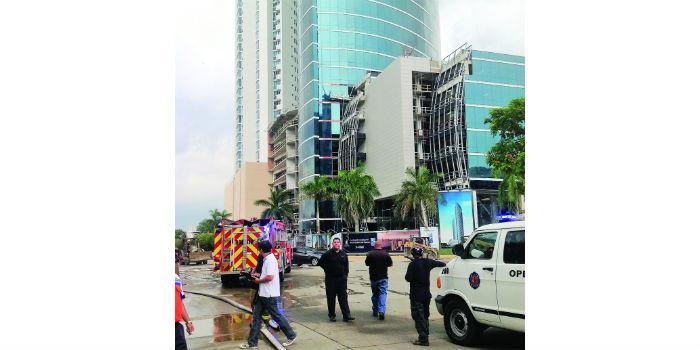 During the construction phase of a building, different fire safety measures and reaction protocols must be taken into account in case a case of these occurs.
During the construction phase of a building, different fire safety measures and reaction protocols must be taken into account in case a case of these occurs.
By Jaime A. Moncada*
One issue that is generally not evaluated during the design process of a building is that of the fire safety measures that should be taken during the construction of a building. The reality is that buildings under construction, as well as buildings that are being renovated or demolished, have a higher probability of catching fire than buildings already built.
There are, during construction, many sources of ignition, such as welding work, temporary electrical connections, and storage of combustible liquids. The fire can easily spread as the building's fire protection systems are unfinished and the building's passive protections are incomplete. The lack of exterior enclosures means that the wind can have an important impact on the rapid development of the flames. The building is packed with workers, while the evacuation stairs are still without adequate enclosures and the fire alarm system is inoperable or not yet installed.
NFPA 1, the Fire Prevention Code, in its Chapter 16, sets forth the safeguards that must exist in a building under construction. This chapter is a summary of NFPA 241, Standard for Safeguarding During the Processes of Construction, Alteration and Demolition of Buildings. These standards establish minimum precautions against fires, which could be quickly summarized as follows:
Water column (standpipe): As construction progresses, the water column must extend parallel to the construction of the building. When a new floor is added and the ladder is installed, the water column must be extended at the same time.
Hoses: Although hoses are no longer required in tall buildings (only hose connections are required), during the construction of the building hoses must be connected with pythons, which must remain connected to the water column in those areas where construction is in progress.
Connections for Firefighters: Water columns should be connected to firefighter connections which should be strategically marked and easily accessible to local firefighters.
Street Hydrants: The fire network and hydrants must be installed, completed and put into service before the construction of the structure can begin. Foundation work is allowed to begin before the completion of hydrants.
Automatic Sprinklers: If the installation of automatic sprinklers is required in the building, these should be put into service as soon as possible.
Fire Alarm: In large or very tall buildings there must be audible alarm equipment to initiate an evacuation alarm.
Stairs: In buildings larger than one story, at least one staircase must be available and usable at all times and meet the requirements of NFPA 101.
Pre-Fire Planning: There must be a plan that sets out how the construction team and local firefighters will deal with a fire in the building during its construction.
Fire Safety Program: A fire safety program should be developed that emphasizes cleaning, safety, installation of fire protection systems, organization and training of the fire brigade, development of Pre-Fire Planning with the local fire department, communication, and considerations of special risks, among others.
On a trip to Panama City, on September 29, 2014 exactly, I had the opportunity to corroborate first-hand the above. I was at a meeting, when we were informed about a fire in progress, in one of the tallest towers in that city. Without a second thought we canceled the meeting, and ran off into the building. The fire broke out around one o'clock in the afternoon on the 52nd floor of an office tower in its final stages of construction. The Tower, called East Coast Financial Park, is located in the south of the city, in one of its most modern areas. The building has a height of 205 meters, a built area of approximately 1,000 m2 per floor, with curtain wall facades. The fire broke out in the cooling tower on the roof of the building.
The building was protected with automatic sprinklers, but these were not operational at the time of the fire. Fortunately, the spectacular fire did not escalate, but it highlighted once again that the architecture that is being built in this city, as in many other Latin American capitals, due to its size and height, requires modern, effective and efficient fire safety systems. When I arrived at the site of the fire I had the opportunity to talk with the firefighters responsible for the emergency who informed me that they had not been able to reach the base of the fire with water, because the water column was not yet operating. I helped them, after a couple of simple calculations, showing them the logistics necessary to be able to reach the fire with water, connecting two fire trucks in series, to the street hydrants, injecting water through the connections for firefighters, and in the connection for hose in the water column on the top floor, finally connecting hoses to be able to extinguish the fire. It became clear to everyone that pre-planning and subsequent training is essential to be able to operate effectively in an emergency in this type of super tall buildings.
As I mentioned earlier, fires during construction are frequent. In recent times I can recall two other major fires in projects where I had the opportunity to work as a fire protection engineer. The first occurred on September 5, 2006, on the 43rd floor of the Torre del Espacio in Madrid, the tallest in Spain (53 floors, 223 m high). The second occurred on October 12, 2012, at the Star Bay Tower in Panama City, where a fire broke out in the second sub-basement of this 65-story (267 m high) tower, the second tallest tower in Panama. In both cases the firefighters had great difficulty in controlling these fires. Another recent and emblematic fire was on February 16, 2011, at the 44-story (215 m) Riu Plaza Hotel, the tallest building in Guadalajara and the second tallest in Mexico, where an explosion in an LPG tank killed two people and injured 16 others.
The lesson for me from all this is that during the construction of any building you must have a minimum infrastructure to be able to control a fire when it is declared. On the other hand, there must be, in the design specifications, a clear strategy on how to maintain a minimum level of fire safety during the construction process.
* Jaime A. Moncada, PE is a director of International Fire Safety Consulting (IFSC), a fire protection engineering consulting firm based in Washington, DC. and with offices in Latin America. He is a fire protection engineer graduated from the University of Maryland, co-editor of the NFPA Fire Protection Manual, former vice president of the Society of Fire Protection Engineers (SFPE), who for 15 years directed NFPA's professional development programs in Latin America. Moncada's email address is [email protected].
























Leave your comment